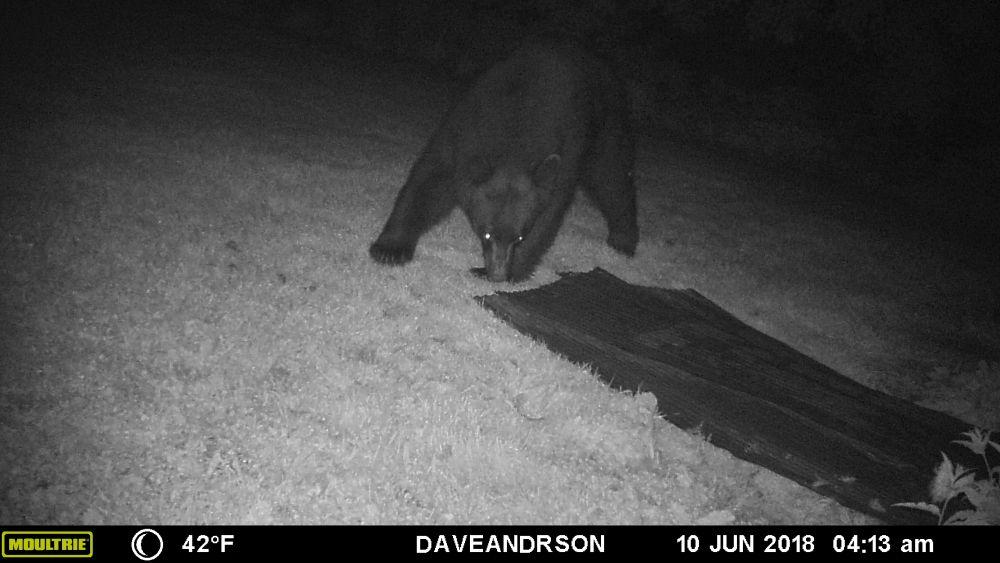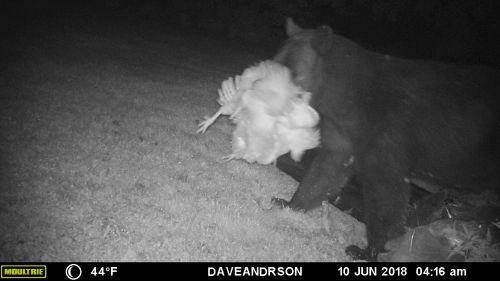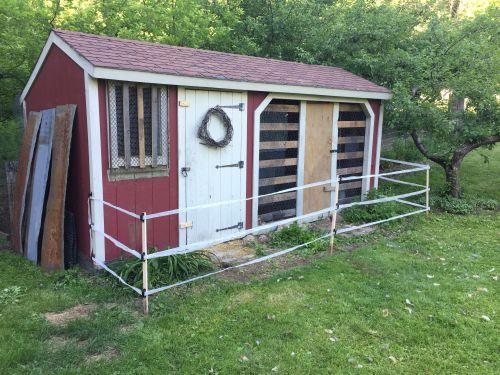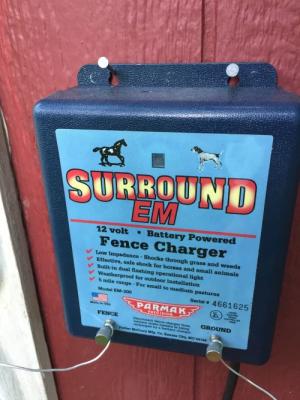Hard won lessons for would-be backyard poultry farmers
- Tags:
- Wildlife

A bigger predator problem in the chicken coop
We’ve experienced an uneasy peace for five consecutive nights, a ceasefire during the two a.m. to five a.m. pre-dawn window when the raids typically occur. We know it was a bear – we saw it on wildlife cameras rigged at the chicken coop. The damage is unmistakable: bent metal, splintered wood, teeth marks, muddy paw prints on the wooden door and a trail of feathers leading into the adjacent woods.
Something new broke into the chicken coop once late last autumn. At the time, we weren’t sure what it was. We never actually saw a bear. It was a “smash and grab” style robbery. A flimsy door was compromised for entry and the unseen beast exited by punching a huge hole through a chicken wire panel on the open portion of the three-sided chicken shed. We lost one hen. We re-enforced the panels and the door with heavy, horizontal wooden slats like a penitentiary and it didn’t happen again… until two weeks ago.
This time the bear is bigger and stronger. When it returned this spring, it climbed up onto an ornamental steel flower box recently planted with pink petunias and flattened it. It ripped off layers of hardware cloth and chicken wire and climbed through the open window. Once inside, it crushed wooden shelves just by sitting upon them. By morning, we were missing the first two of our flock of 25 laying hens.
This past weekend, the coop was particularly vulnerable. We were visiting our newborn grandson. The house was dark with no dog, people traffic or noise. A bear broke into the hen house early Saturday and Sunday mornings killing and partially eating four more hens. When my son and his wife got home just before midnight on Saturday, a bear bolted from the coop via the smashed chicken wire door and walked into the woods. It was close enough for them to hear its paws splashing in the creek and rustling in dry leaves as it walked off. Notably, it didn’t run. Instead, it came back for two more hens at four a.m. Another hen died two days later from injuries sustained in the bear raid. Having lost nine hens, we’re down to sixteen.

We got home Sunday afternoon and started scrambling. The bear had feasted in the woods. I rigged wildlife cameras along the trail of feathers and over grisly, half-eaten hen carcasses now click bait. I checked the memory card on the chicken coop camera which revealed a three-year-old bear – likely a male I’m guessing weighs 200 pounds.
We had a resident sow with triplet cubs two years ago. We’d seen a lone male bear often last autumn eating fallen apples in the orchard adjacent to the fenced chicken yard. I met a lone bear during deer season on our woodlot. It was never really a matter of “if” but only a matter of “when” some bear would show interest in our chicken coop.
Like Fort Knox
It was past time to improve our defenses. We reinforced the coop by screwing heavy steel mesh over the window – mesh salvaged from an urban apartment building renovation by a pack-rat friend. We covered the chicken wire and hardware cloth door with two panels of plywood and we added removable sheets of corrugated steel to the wooden slat opening at night. It looks more like a Bronx pharmacy than a South Sutton chicken coop.
At night we lock our remaining chickens inside at dusk. We close the hatch leading to the fenced orchard. We arrange the corrugated steel panels and anchor them in place. We keep back porch and garage lights on to illuminate the coop. We have also stapled socks filled with mothballs to the walls under the eaves. Bags of mothballs or rags soaked with chlorine bleach offend bears’ noses. Bears don’t see particularly well but they smell in technicolor.

The most critical upgrade was addition of a 24:7 electric fence perimeter. We’re heeding the advice of Lyme, NH black bear expert, Ben Kilham who suggests poultry farmers electrify a perimeter fence and “educate” local bears by placing a wet sponge baited with peanut butter or bacon grease on the fence so a bear drawn-in gets zapped. Kilham says bears thus educated “will lose all interest in what lies behind the fence.”
The first night after returning home to carnage and much carpentry, I was wakeful, sleeping by the open window with a flashlight and a loaded .30-.30 rifle at the door. But truly the LAST thing I wanted to do was shoot a bear. Aiming to miss for the noise effect wouldn’t deter it for long. Bears are hard-wired to find food. Once they locate a reliable food source – birdfeeders, dumpsters, pet food bowls, barbecue grills or chicken coops - they’ll exploit it until it’s gone. In effect, our chicken coop had become bear attractant, like a giant open bag of sunflower seeds.

NH Fish and Game recently killed an aggressive bear in Cornish that threatened homeowners even in mid-day. It returned repeatedly and began defending their chicken coop as its food source. A colleague in New London had her family’s chicken coop door ripped right off its hinges and they lost several hens. A bear in Andover was relocated.
We’ve discovered the bear isn’t alone. Our cameras revealed coyotes, crows, a raccoon and gray foxes scavenging the chicken carcasses in the first 48 hours. Crows and the bear appear during daylight hours. Nighttime is busier with raccoons, coyotes and foxes. Fresh dead chickens don’t last long because hungry scavengers are plentiful. Backyard chicken coops smell like food to carnivores. Our farm is like a local fast-food miracle mile, a calorie alley of which Colonel Sanders could be proud.
“Eternal vigilance is the price of liberty”
– Abolitionist, Wendell Philips
So far, our effort to keep the remaining chickens alive seems to be working – at least for now. We wonder if the bear hasn’t come back to bash open the coop because of the electric fence? Or the corrugated steel across the front? Maybe the most powerful bear deterrent is the mothballs?
In the past we lost chickens to hawks, weasels, mink, raccoons, foxes and a bobcat. We’ve found skunks and opossums beneath the coop. But a hungry bear is different. I find myself watching over my shoulder when I go to retrieve the memory card from the chicken carcass cameras.
This bear war isn’t over; it’s ongoing... and it will continue next year. The bear continues lurking in the backyard woods. As I write this, he’s out there now. We deploy defenses nightly and we monitor the wildlife cameras. The whole ordeal has me questioning once again if farm-fresh backyard eggs are worth the heartache.
People move to bear country. Some then expect NHFG to bail them out when bears cause problems. Certainly the NHFG “red line” policy of killing bears that enter homes makes sense. Obviously, public safety comes first.
And yet, more NH bears are being killed and more young bear cubs are being orphaned in recent years with the growing popularity of backyard poultry. Shooting bears to save chickens seems an awful waste of wild bears. It shouldn’t happen.
The truth is predator problems are really fence problems. Fence problems are a farmer’s responsibility. Would-be backyard farmers need to better manage the security of domestic livestock, be it chickens, sheep, pigs, goats, ducks, geese, llamas or alpacas.
A bear can’t be blamed for using its instincts. Would you fault a bear for being hungry? Bears will continue to do what they are best adapted to do: find food.
